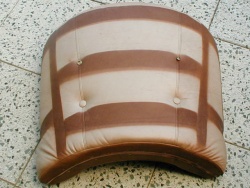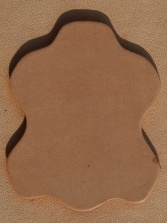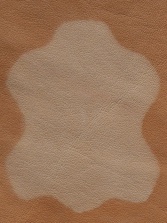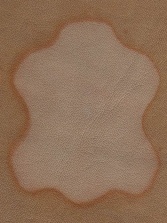Difference between revisions of "Colour fastness - Light fastness of leather"
| Line 31: | Line 31: | ||
<p> </p> | <p> </p> | ||
| − | + | The light fastnesses of leather - as well as in the textile industry - are measured by means of the so-called blue scale. In doing so, eight blue wool strips of descending light fastness are placed together with a sample of the leather to be tested in ultraviolet light. Before, part of the sample surface and a part of the wool strip surface is covered and compared after the exposure. The degrees of light fastnesses are expressed as follows: | |
| Line 76: | Line 76: | ||
| − | + | For leather, grade 6 is already referred to as light resistant, since it fades faster than textiles. [[Aniline leather]] at least must have grade 3 or 4. | |
Revision as of 12:04, 31 January 2017
Contents
Light fastness of leather
The fading of leather is one of the main reasons for damage to leather objects, besides damages caused by perspiration, mechanical stress and aging.
The lightfastness of a material describes its resistance to fading by light, in particular by the constant irradiation of UV light. Among the types of leather, especially aniline-colored porous leather is at risk of losing the original hue. The less warm and natural pigmented leather are less endangered.
Aniline leather day 0, day 16 and day 50 in sunlight.
Faded, embossed nubuck in comparison to the original pattern.
The light fastnesses of leather - as well as in the textile industry - are measured by means of the so-called blue scale. In doing so, eight blue wool strips of descending light fastness are placed together with a sample of the leather to be tested in ultraviolet light. Before, part of the sample surface and a part of the wool strip surface is covered and compared after the exposure. The degrees of light fastnesses are expressed as follows:
| Degree | designation | corresponds in Central Europe an exposure time of |
|---|---|---|
| 8 | outstanding | 700 days |
| 7 | excellent | 350 days |
| 6 | very good | 160 days |
| 5 | good | 80 days |
| 4 | pretty good | 40 days |
| 3 | moderate | 20 days |
| 2 | low | 10 days |
| 1 | very low | 5 days |
For leather, grade 6 is already referred to as light resistant, since it fades faster than textiles. Aniline leather at least must have grade 3 or 4.
Xenon test
Im Labor gibt es Geräte, die die Ausbleichempfindlichkeit messen. Üblich ist der Xenon-Test, der versucht das Sonnenlicht zu simulieren.
Der Xenon-Test zeigt die Ausbleichempfindlichkeit. Die Narbenseite ist erkennbar verblichen.
Einflussgrößen auf die Ausbleichempfindlichkeit
Folgende Parameter beeinflussen die Ausbleichempfindlichkeit:
- Für die Ausbleichempfindlichkeit ist nicht das Leder, sondern maßgeblich der eingesetzte Farbstoff verantwortlich.
- Nicht alle Farbstoffe sind gleich Ausbleichempfindlich. Zwei verschieden Schwarz- oder Rottöne können sich komplett unterschiedlich empfindlich zeigen. Gewissheit über die Ausbleichempfindlichkeit liefern nur Vergleichstests. Die Empfindlichkeit gegen Lichteinflüsse kann man mit dem Xenon-Test prüfen.
- Je mehr Farbstoff auf Leder aufgetragen wird, desto besser sind die Lichtechtheiten. Leider beeinträchtigen starke Farbaufträge die Haptik des Leder.
- Bei im gleichen Farbton durchgefärbten Ledern ist die Ausbleichempfindlichkeit geringer.
- UV-Schutzlacke verbessern das Ausbleichverhalten des Leders.
- Das Ausbleichverhalten von Rauledern und Anilinledern ist nicht unterschiedlich.
- Das Ausbleichverhalten von Textilien bei identisch verwendeten Farbstoffen ist aufgrund der besseren Fixierbarkeit der Farbstoffe bei Textilien deutlich besser.
Anilinleder in der Mitte abgedeckt nach 2,5 Monaten im Sonnenfenster.
Welche Auswirkungen UV-Licht auf die Optik eines unzureichend lichtechten Lederartikels haben kann, demonstrieren die folgenden Abbildungen. Sie zeigen den Farbkontrast zwischen Stellen, die nicht dem Sonnenlicht ausgesetzt waren, im Vergleich zu der übrigen Oberfläche. Die Beispiele zeigen Anilin- und Nubukleder.
Vegetable-tanned leather
The dye in aniline leather or the pigment based coatings on finished leather become lighter by light. In the case of uncolored vegetal tanned leathers, it behaves differently. The leather darkens by light. And the darkness can fade with time. Probably this effect is related to fats and oils in the leather.
Vegetable-tanned leather day 0, day 16 and day 50 in sunlight.
Additional information
























 a kotori web solution
a kotori web solution